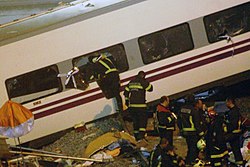Santiago de Compostela derailment

Rescue efforts on 24 July 2013
|
|
| Date | 24 July 2013 |
|---|---|
| Time | 20:41 CEST (UTC+02:00) |
| Location | Angrois, Santiago de Compostela, Galicia 3.2 km (2.0 mi) SE from Santiago de Compostela |
| Coordinates | 42°51′34.2″N 8°31′40″W / 42.859500°N 8.52778°WCoordinates: 42°51′34.2″N 8°31′40″W / 42.859500°N 8.52778°W |
| Country | Spain |
| Rail line | Madrid–Ferrol |
| Operator | Renfe |
| Type of incident | Derailment |
| Cause | Overspeed on curve |
| Statistics | |
| Trains | 1 |
| Passengers | 218 |
| Crew | 4 |
| Deaths | 80 |
| Injuries | 140 |
| Damage | Eight carriages, one dining car, two generator cars, two locomotives |
The Santiago de Compostela derailment occurred on 24 July 2013, when an Alvia high-speed train travelling from Madrid to Ferrol, in the north-west of Spain, derailed at high speed on a bend about 4 kilometres (2.5 mi) outside of the railway station at Santiago de Compostela, Spain. Of the 222 people (218 passengers and 4 crew) aboard, around 140 were injured and 79 died.
The train's data recorder showed that it was travelling at about twice the posted speed limit of 80 kilometres per hour (50 mph) when it entered a bend in the line. The crash was recorded on a track-side camera which shows all thirteen train cars derailing and four overturning. On 28 July 2013, the train's driver Francisco José Garzón Amo was charged with 79 counts of homicide by professional recklessness and an undetermined number of counts of causing injury by professional recklessness.
The crash was Spain's worst rail disaster in 40 years, since a crash near El Cuervo, Seville, in 1972. The Torre del Bierzo crash in 1944 remains the deadliest.
Spain has one of the world's most extensive high-speed railway (HSR) networks, built and maintained by the infrastructure company Adif and run by the state-owned operator Renfe that manages the .
The Olmedo-Zamora-Galicia high-speed rail line is only partially completed, with some sections of the HSR already in service while other sections still remain as a conventional railway line.
The RENFE Class 730 passenger train is in service on this line, as it can run on both conventional and high-speed tracks. It also has two generator cars that allow its electric traction motors to function on non-electrified lines, but which bring its weight per axle well over the normal value for high velocity trains. It is essentially a hybrid system, and it is built up of pieces which had not been accredited as a whole. It has a top speed of 180 kilometres per hour (110 mph) when running in diesel mode, and around 260 kilometres per hour (160 mph) when running on overhead electrification.
...
Wikipedia
